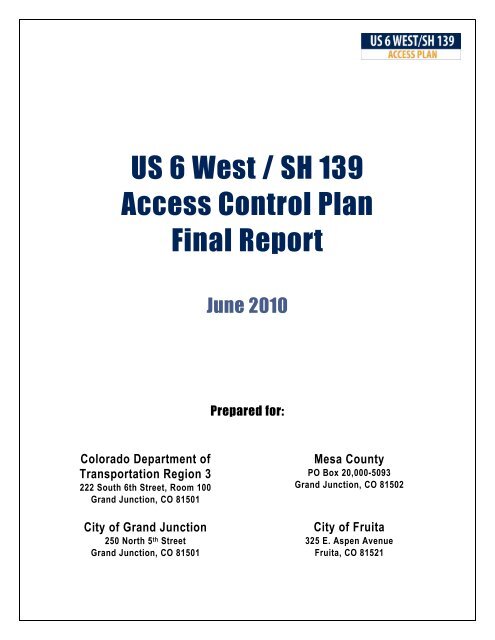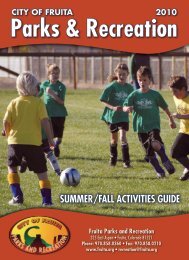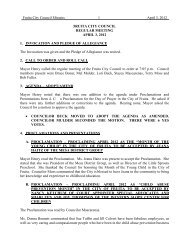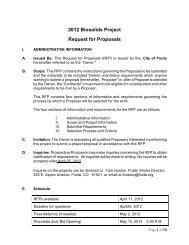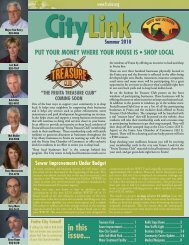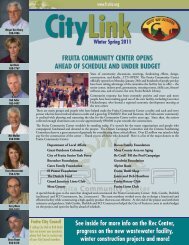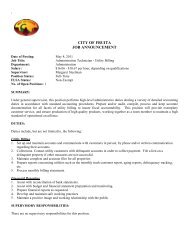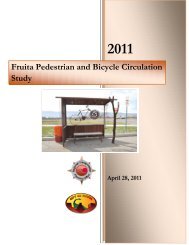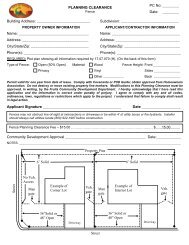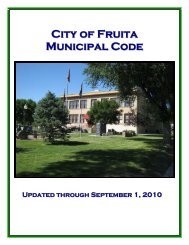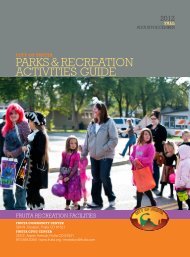US 6 West / SH 139 Access Control Plan Final Report - City of Fruita
US 6 West / SH 139 Access Control Plan Final Report - City of Fruita
US 6 West / SH 139 Access Control Plan Final Report - City of Fruita
- No tags were found...
You also want an ePaper? Increase the reach of your titles
YUMPU automatically turns print PDFs into web optimized ePapers that Google loves.
<strong>US</strong> 6 <strong>West</strong> / <strong>SH</strong> <strong>139</strong><strong>Access</strong> <strong>Control</strong> <strong>Plan</strong><strong>Final</strong> <strong>Report</strong>June 2010Prepared for:Colorado Department <strong>of</strong>Transportation Region 3222 South 6th Street, Room 100Grand Junction, CO 81501<strong>City</strong> <strong>of</strong> Grand Junction250 North 5 th StreetGrand Junction, CO 81501Mesa CountyPO Box 20,000-5093Grand Junction, CO 81502<strong>City</strong> <strong>of</strong> <strong>Fruita</strong>325 E. Aspen Avenue<strong>Fruita</strong>, CO 81521
<strong>US</strong> 6 <strong>West</strong>/<strong>SH</strong> <strong>139</strong> <strong>Access</strong> <strong>Control</strong> <strong>Plan</strong> <strong>Final</strong> <strong>Report</strong>June 2010Table <strong>of</strong> Contents1.0 Introduction ............................................................................................................................................................................ 11.1 What is an <strong>Access</strong>? ............................................................................................................................................................. 11.2 What is an <strong>Access</strong> <strong>Control</strong> <strong>Plan</strong>?......................................................................................................................................... 11.3 <strong>Access</strong> <strong>Control</strong> <strong>Plan</strong> Benefits ............................................................................................................................................... 21.4 Study Location ..................................................................................................................................................................... 21.5 <strong>Access</strong> <strong>Control</strong> <strong>Plan</strong> Process ............................................................................................................................................... 31.6 <strong>Plan</strong> Implementation ............................................................................................................................................................ 42.0 General <strong>Access</strong> Requirements .............................................................................................................................................. 72.1 Functional Characteristics <strong>of</strong> Study Limits ........................................................................................................................... 72.2 Specific <strong>Access</strong> Requirements for Study Limits ................................................................................................................... 83.0 Existing Conditions ................................................................................................................................................................ 103.1 Property Owner Information ................................................................................................................................................. 103.2 <strong>Access</strong> Locations and Allowable Movements ...................................................................................................................... 103.3 Existing Traffic Volumes ...................................................................................................................................................... 113.4 Existing Level <strong>of</strong> Service ...................................................................................................................................................... 113.5 Accident Analysis ................................................................................................................................................................. 133.6 Accident History and Problem Analysis ............................................................................................................................... 134.0 Projected Conditions for the Year 2035 ................................................................................................................................ 184.1 Year 2035 Traffic Volumes .................................................................................................................................................. 184.2 Year 2035 No <strong>Access</strong> <strong>Control</strong> <strong>Plan</strong> Level <strong>of</strong> Service ........................................................................................................... 185.0 <strong>Access</strong> <strong>Control</strong> Techniques ................................................................................................................................................... 205.1 Applications <strong>of</strong> <strong>Access</strong> <strong>Control</strong> Techniques on <strong>US</strong> 6 and <strong>SH</strong> <strong>139</strong> ....................................................................................... 206.0 Public Involvement Process .................................................................................................................................................. 236.1 First Open Houses ............................................................................................................................................................... 236.2 Property Owner Meetings/Workshops ................................................................................................................................. 236.3 Second Open Houses .......................................................................................................................................................... 256.4 Website Postings ................................................................................................................................................................. 266.5 Presentations to Elected Officials ........................................................................................................................................ 267.0 <strong>Access</strong> <strong>Control</strong> <strong>Plan</strong> Recommendations .............................................................................................................................. 277.1 Future Traffic Conditions with <strong>Access</strong> <strong>Control</strong> <strong>Plan</strong> Implementation ................................................................................... 277.2 Year 2035 With <strong>Access</strong> <strong>Control</strong> <strong>Plan</strong> Level <strong>of</strong> Service ........................................................................................................ 278.0 Next Steps ............................................................................................................................................................................... 298.1 Approval Process ................................................................................................................................................................. 298.2 <strong>Plan</strong> Implementation ............................................................................................................................................................ 309.0 References ............................................................................................................................................................................... 31Appendix A: <strong>Access</strong> <strong>Control</strong> <strong>Plan</strong> FiguresAppendix B: <strong>Access</strong> <strong>Control</strong> <strong>Plan</strong>Appendix C: Inter-Governmental AgreementAppendix D: Existing, 2035 No <strong>Access</strong> <strong>Control</strong> <strong>Plan</strong>, 2035 With <strong>Access</strong> <strong>Control</strong> <strong>Plan</strong> LOS ResultsAppendix E: Existing, 2035 No <strong>Access</strong> <strong>Control</strong> <strong>Plan</strong>, 2035 With <strong>Access</strong> <strong>Control</strong> <strong>Plan</strong> AM & PM Peak Hour Traffic VolumesAppendix F: Existing Intersection Capacity Analysis AM & PMAppendix G: 2035 No <strong>Access</strong> <strong>Control</strong> <strong>Plan</strong> Intersection Capacity Analysis AM & PMAppendix H: 2035 With <strong>Access</strong> <strong>Control</strong> <strong>Plan</strong> Intersection Capacity Analysis AM & PMAppendix I: Accident DataAppendix J: Turn Movement Counts (TMC)Appendix K: First Open House MaterialAppendix L: Second Open House MaterialAppendix M: Average Daily Traffic (ADT)Appendix N: One-on-One CorrespondenceAppendix O: Property Mailing ListColorado Department <strong>of</strong> Transportation – Mesa County – <strong>City</strong> <strong>of</strong> Grand Junction – <strong>City</strong> <strong>of</strong> <strong>Fruita</strong>
<strong>US</strong> 6 <strong>West</strong>/<strong>SH</strong> <strong>139</strong> <strong>Access</strong> <strong>Control</strong> <strong>Plan</strong> <strong>Final</strong> <strong>Report</strong>June 20101.0 INTRODUCTIONThe Colorado Department <strong>of</strong> Transportation (CDOT) Region 3, Mesa County, the <strong>City</strong> <strong>of</strong> Grand Junction, the <strong>City</strong> <strong>of</strong><strong>Fruita</strong> (the agencies), and the Mesa County Regional Transportation <strong>Plan</strong>ning Office have identified the need for an<strong>Access</strong> <strong>Control</strong> <strong>Plan</strong> along designated portions <strong>of</strong> United States Highway 6 (<strong>US</strong> 6) and State Highway <strong>139</strong> (<strong>SH</strong> <strong>139</strong>).To the extent feasible, given existing conditions, this comprehensive access plan will bring these portions <strong>of</strong> highwayinto conformance with their respective access category and functional needs. The plan seeks to achieve the optimumbalance between state and local transportation objectives, and preserve and support the current and future functionalintegrity <strong>of</strong> the highway.This <strong>Access</strong> <strong>Control</strong> <strong>Plan</strong> will become a binding document to guide the agencies’ decisions regarding the futureaccess conditions along <strong>US</strong> 6 and <strong>SH</strong> <strong>139</strong>. The State Highway <strong>Access</strong> Code, Volume 2, Code <strong>of</strong> Regulations 601-1,March 2002 was followed in preparing this plan. This report provides the requirements, the objectives, and theprocess for the <strong>Access</strong> <strong>Control</strong> <strong>Plan</strong>.1.1 What is an <strong>Access</strong>?Generally defined, an “access” is a way or means <strong>of</strong> connecting properties to the roadway, thereby allowing vehiclesto move from one destination to another. <strong>Access</strong>es come in all shapes and sizes; ranging from a residential drivewayconnecting to a local street to an arterial roadway connecting to a freeway. <strong>Access</strong>es are key components to asuccessful transportation system. Without clearly defined accesses, vehicles are unable to efficiently move people orgoods between destinations, thereby impeding day-to-day life and business transactions. Managing access providesa means <strong>of</strong> systematic control <strong>of</strong> the location, spacing, design, and operation <strong>of</strong> driveways, median openings,interchanges, and street connections to a roadway.1.2 What is an <strong>Access</strong> <strong>Control</strong> <strong>Plan</strong>?A comprehensive access management program supports safe and efficient operations for all modes <strong>of</strong>transportation. An access control plan is an organized and deliberate strategy that regulates the number and types <strong>of</strong>existing and future accesses allowed along a section <strong>of</strong> roadway. An access control plan makes recommendationsfor appropriate modifications regarding the location and distance between accesses as well as the lane configurationand spacing <strong>of</strong> traffic signals.Managing access points along a corridor helps to maintain operations for different roadway classifications. Forinstance, a major highway should have less access points than a neighborhood street. Generally, major highwaysmaintain a higher speed limit to accommodate a larger volume <strong>of</strong> traffic. If a highway has too many access points, theoverall speed could decrease and accidents may increase. However, a neighborhood street generally has a slowerspeed limit and accommodates a smaller number <strong>of</strong> vehicles. Therefore, it is appropriate for a neighborhood street tohave more access points than a highway.An access control plan takes into consideration the traffic characteristics <strong>of</strong> a roadway, the use and character <strong>of</strong>adjacent public or private property, and future planning goals. Because regulating access points can positively ornegatively alter the actual or perceived value <strong>of</strong> adjacent properties, those who are creating the access control planmust actively work with property owners and city planners to create the best possible solution.1Colorado Department <strong>of</strong> Transportation – Mesa County<strong>City</strong> <strong>of</strong> Grand Junction – <strong>City</strong> <strong>of</strong> <strong>Fruita</strong>
<strong>US</strong> 6 <strong>West</strong>/<strong>SH</strong> <strong>139</strong> <strong>Access</strong> <strong>Control</strong> <strong>Plan</strong> <strong>Final</strong> <strong>Report</strong>June 20101.3 <strong>Access</strong> <strong>Control</strong> <strong>Plan</strong> BenefitsAccording to national studies 1 , an effective access control plan can reduce the number <strong>of</strong> crashes by as much as50%. When a motorist is presented with a complex driving situation due to an excessive number <strong>of</strong> accesses that aretoo close together, more collisions occur. Accidents generally occur either during a disruption in flow (meaning thevehicle ahead is decelerating due to a turn or other cause) or at a conflict point (where two vehicles’ paths cross). Forexample, restricting allowable movements from a full movement access to a ¾ access (right-in, right-out with left-turnmovement) or to a right-in and right-out access, potentially reduces the severity <strong>of</strong> an accident by reducing thenumber <strong>of</strong> left-turning vehicles. These vehicles can be redirected to adjacent signalized intersections, where underthe protections <strong>of</strong> additional auxiliary lanes and a traffic signal, the vehicles can either turn left or make a U-turn toreach their desired destination. In order to create a safer but still efficient corridor, a balance must be made indetermining the location, spacing, and allowable movements <strong>of</strong> each access, without compromising access to theadjacent properties. A less complex and therefore safer driving situation is accomplished when the number <strong>of</strong>conflicts between vehicles is reduced.When the number <strong>of</strong> accesses along a roadway is condensed, desired speeds are maintained and motorists canarrive more quickly at their destinations. Studies 1 have shown that location <strong>of</strong> driveways can reduce average travelspeeds by up to 5 to 10 mph. Additionally, travel time on a segment is increased when the number <strong>of</strong> traffic signals isminimized and the spacing between the signals is more uniform. As vehicular speeds along a roadway become morestable, motorists can see an added benefit <strong>of</strong> maximum fuel efficiency. Additionally, improved traffic flow translatesinto better air quality due to a decrease in vehicle emissions.Roads are important public resources that are costly to build and to improve or replace. Implementing an accesscontrol plan reduces the cost <strong>of</strong> maintaining the corridor. When access management principles are set aside,property owners experience an unpredictable development environment. Roadways that are overused will bewidened and later widened again, creating an ever-changing landscape and recurring road construction. In arevenue-constrained environment, effective management <strong>of</strong> the transportation system is essential.1.4 Study LocationThe <strong>Access</strong> <strong>Control</strong> <strong>Plan</strong> evaluates <strong>US</strong> 6 from 12 Road west <strong>of</strong> Loma, to 24 Road (approximately at RedlandsParkway) in the <strong>City</strong> <strong>of</strong> Grand Junction, as well as <strong>SH</strong> <strong>139</strong> from N ¼ Road north <strong>of</strong> Loma, to I-70 south <strong>of</strong> Loma. Thisstudy covers approximately 14 ½ miles along <strong>US</strong> 6 and 2 ¼ miles along <strong>SH</strong> <strong>139</strong>. The study areas are shown inFigure 1.1 <strong>Access</strong> Management Manual: Committee on <strong>Access</strong> Management. Washington D.C.: Transportation Research Board <strong>of</strong> theNational Academies, 2003.2Colorado Department <strong>of</strong> Transportation – Mesa County<strong>City</strong> <strong>of</strong> Grand Junction – <strong>City</strong> <strong>of</strong> <strong>Fruita</strong>
<strong>US</strong> 6 <strong>West</strong>/<strong>SH</strong> <strong>139</strong> <strong>Access</strong> <strong>Control</strong> <strong>Plan</strong> <strong>Final</strong> <strong>Report</strong>June 2010Figure 1: Mesa County <strong>Access</strong> <strong>Control</strong> <strong>Plan</strong> Study Area1.5 <strong>Access</strong> <strong>Control</strong> <strong>Plan</strong> ProcessThe first step to creating the <strong>Access</strong> <strong>Control</strong> <strong>Plan</strong> for the study corridor was the collection <strong>of</strong> data. This included turnmovement counts, daily traffic volumes, accident reports, and other information pertaining to the study corridors. Afterthe data was collected, a safety and operational analysis was performed. With this information, while meeting theState Highway <strong>Access</strong> Code, alternatives for the accesses along the corridors were developed. These alternativeswere then reviewed and revised by the agencies’ participating representatives and later presented at the first publicOpen Houses. Afterwards, additional meetings were conducted with property owners (individuals and groups) whohad specific concerns and/or unique design conditions. The information and feedback received from the public wasthen incorporated into the <strong>Access</strong> <strong>Control</strong> <strong>Plan</strong> and presented at the second and final Open Houses. Based on inputreceived at the final Open Houses, further refinements were incorporated into the <strong>Access</strong> <strong>Control</strong> <strong>Plan</strong> to bring thecorridor into conformance with its future and functional purposes and to improve safety. For more information onpublic involvement, refer to Volume 2, Section 6.0.The completion <strong>of</strong> this report indicates the beginning <strong>of</strong> the Inter-Governmental Agreement (IGA) and adoption process which consists <strong>of</strong> the following steps:• Present the final draft to the public and local elected <strong>of</strong>ficials.• Formally adopt the plan by:o An agreement between CDOT, Mesa County, the <strong>City</strong> <strong>of</strong> <strong>Fruita</strong>, and the <strong>City</strong> <strong>of</strong> Grand Junction.o Approval by the Colorado Transportation Commission and the CDOT Chief Engineer.3Colorado Department <strong>of</strong> Transportation – Mesa County<strong>City</strong> <strong>of</strong> Grand Junction – <strong>City</strong> <strong>of</strong> <strong>Fruita</strong>
<strong>US</strong> 6 <strong>West</strong>/<strong>SH</strong> <strong>139</strong> <strong>Access</strong> <strong>Control</strong> <strong>Plan</strong> <strong>Final</strong> <strong>Report</strong>June 20101.6 <strong>Plan</strong> ImplementationIt is important to remember that the <strong>Access</strong> <strong>Control</strong> <strong>Plan</strong> is intended to represent a long range plan for the studyroadways. Implementation <strong>of</strong> the full plan can occur as a single project, or over the long term in smaller incrementsas a phased approach. Figure 2 provides details about how the <strong>Access</strong> <strong>Control</strong> <strong>Plan</strong> may be implemented as aphased approach.Implementation <strong>of</strong> the full plan at a single time is unlikely and would only occur as part <strong>of</strong> a transportationimprovement project that included all <strong>of</strong> the study roadways. This would be a publicly funded project by anycombination <strong>of</strong> local and CDOT funding. A future public project would include the access changes described in the<strong>Access</strong> <strong>Control</strong> <strong>Plan</strong>, which could be implemented at the time. There are currently no projects planned for theportions <strong>of</strong> <strong>US</strong> 6, except for intersection improvements at <strong>SH</strong> <strong>139</strong>. There are also no other improvements currentlyplanned on <strong>SH</strong> <strong>139</strong>, except for the intersection improvements at <strong>SH</strong> <strong>139</strong> and <strong>US</strong> 6. This means there is not a projecton the Long Range Transportation <strong>Plan</strong>, the Fiscally Constrained <strong>Plan</strong>, or the currently funded StatewideTransportation Improvement <strong>Plan</strong>. A corridor wide project in the near future is unlikely. Highway projects take manyyears to identify, fund, and construct. Under this scenario, it would be the government’s responsibility to make theaccess changes to the highway. Even with a public corridor project, it would be unlikely that the entire plan could beimplemented at one time because access must still be provided to each property on the corridor. For example, if aproperty has not redeveloped, it might not be feasible to relocate the driveway; or if the local street network has notbeen completed, alternative access may not be available. In cases like this, an interim access to the property wouldbe maintained until such time as the ultimate access configuration could be achieved.As traffic grows along the study roadways, the agencies will be faced with deciding how to implement the <strong>Access</strong><strong>Control</strong> <strong>Plan</strong>. One approach may be to implement interim roadway improvements that would delay the need toimplement the ultimate recommendations <strong>of</strong> the <strong>Access</strong> <strong>Control</strong> <strong>Plan</strong>.Once traffic volumes and/or safety issues indicate changes to access conditions are needed, the next phase <strong>of</strong> theimplementation would be to identify locations where raised medians, traffic signals or other forms <strong>of</strong> traffic control arewarranted. When intersections or access points have operational or safety concerns CDOT will look for ways toaddress these issues. These projects would most likely incorporate portions <strong>of</strong> the <strong>Access</strong> <strong>Control</strong> <strong>Plan</strong>, such asimplementing turn restrictions or improving intersections in order to improve operations or increase safety along thecorridor.It is recognized by all the parties involved that high quality economic development is critical to local communities andthe State and that economic development must play a significant role in this plan. Because land use developmentand the associated access control is a key component <strong>of</strong> economic development, this plan will work tosimultaneously improve access safety and planning and provide for orderly, effective, and economically prudentdevelopment goals.CDOT, with consultation <strong>of</strong> the local agencies, will consider the economic impacts associated with planimplementation. In conjunction with the engineering and traffic analysis, these economic impacts will assist indetermining the extent <strong>of</strong> the highway improvements required through the access permit process and implementation<strong>of</strong> the access control plan. Implementation will take into consideration that some development will likely occur beforethe traffic volumes require the ultimate configuration shown on the access control plan. The highway improvementsmay be phased before implementing the full access restrictions shown. <strong>Access</strong> modifications and restrictions maynot be fully implemented until safety or operational issues develop if CDOT, in conjunction with its local partners,determines through an engineering analysis that the improvements are not required at the time <strong>of</strong> the development.4Colorado Department <strong>of</strong> Transportation – Mesa County<strong>City</strong> <strong>of</strong> Grand Junction – <strong>City</strong> <strong>of</strong> <strong>Fruita</strong>
<strong>US</strong> 6 <strong>West</strong>/<strong>SH</strong> <strong>139</strong> <strong>Access</strong> <strong>Control</strong> <strong>Plan</strong> <strong>Final</strong> <strong>Report</strong>June 2010When any level <strong>of</strong> implementation <strong>of</strong> the access control plan is delayed, the access permit for the property willinclude notification to the owner that full implementation <strong>of</strong> the plan will be required at a later date. The intent is toprovide property owners with the information needed to successfully develop properties while working towards thelong term access plan, local planning objectives, and economic development efforts for the corridor.The most common trigger for the phased approach relates to when a property along <strong>US</strong> 6 or <strong>SH</strong> <strong>139</strong> develops,redevelops, or if a driveway experiences a traffic volume increase <strong>of</strong> 20 percent or more (per the State Highway<strong>Access</strong> Code). Under this scenario, a new CDOT access permit is required and CDOT would work with the propertyowner or the developer to make the access changes and highway improvements in the area directly impacted by thedevelopment/redevelopment. Coordination through the development process is critical to the ultimate success <strong>of</strong> theplan. If the ultimate <strong>Access</strong> <strong>Control</strong> <strong>Plan</strong> cannot be implemented when a property redevelops, the property shoulddevelop in such a way as to not prohibit the plan implementation. For example, buildings should be constructed insuch a manner as to utilize a future access location shown on the plan. Even if project related traffic volumes do notwarrant the full implementation <strong>of</strong> the plan, the local entities should develop a method to collect funds from theowner/developer with the understanding that the changes will be necessary in the future. This may encourage somedevelopment to occur now, but the local entity will have collected funds to help <strong>of</strong>fset the cost <strong>of</strong> the futureimprovements. This is especially important in the case where a property simply redevelops, but does not increase thetraffic generated by 20% or more. If the local entity does not implement the plan at the same time or collect funds forfuture implementation, it is unlikely the same property would redevelop again before the changes are necessary,creating a missed opportunity to implement the plan or collect contributions toward the improvements.Another important aspect <strong>of</strong> the implementation process is how access is granted to new developments. Eachproperty along the study roadways must be provided reasonable access. CDOT should work with theowner/developer to ensure projects are designed with consideration to where access will be permitted in the ultimate<strong>Access</strong> <strong>Control</strong> <strong>Plan</strong>. <strong>Access</strong> will be provided to the property as shown on the <strong>Access</strong> <strong>Control</strong> <strong>Plan</strong> unless it is notfeasible to implement at the time <strong>of</strong> the development. Then, an interim access will be permitted, which will changeonce the ultimate access conditions can be achieved. Coordinating with the owner/developer throughout the projectdevelopment process will ensure the final design <strong>of</strong> the property does not preclude the implementation <strong>of</strong> the final<strong>Access</strong> <strong>Control</strong> <strong>Plan</strong> configuration on the study roadways.The outcome <strong>of</strong> this study is the <strong>US</strong> 6/<strong>SH</strong> <strong>139</strong> <strong>Access</strong> <strong>Control</strong> <strong>Plan</strong>, which identifies the number, location, and type <strong>of</strong>access points that will be allowed on the study roadways within the study limits. However, future changes to the planare allowed based upon the guidelines <strong>of</strong> the State Highway <strong>Access</strong> Code, according to Section 2.12, “<strong>Access</strong><strong>Control</strong> <strong>Plan</strong>s” (p. 30, paragraph 3): The plan must receive the approval <strong>of</strong> both the Department and the appropriatelocal authority to become effective. This approval shall be in the form <strong>of</strong> a formal written agreement signed by thelocal authority and the Chief Engineer <strong>of</strong> the Department. After an access control plan is in effect, modifications to theplan must receive the approval <strong>of</strong> the local authority and the Department. Where an access control plan is in effect,all action taken in regard to access shall be in conformance with the plan and current Code design standards unlessboth the Department and the local authority approve a geometric design waiver under the waiver subsection <strong>of</strong> theCode.5Colorado Department <strong>of</strong> Transportation – Mesa County<strong>City</strong> <strong>of</strong> Grand Junction – <strong>City</strong> <strong>of</strong> <strong>Fruita</strong>
<strong>US</strong> 6 <strong>West</strong>/<strong>SH</strong> <strong>139</strong> <strong>Access</strong> <strong>Control</strong> <strong>Plan</strong> <strong>Final</strong> <strong>Report</strong>June 2010Figure 2: <strong>Access</strong> <strong>Control</strong> <strong>Plan</strong> Implementation Process6Colorado Department <strong>of</strong> Transportation – Mesa County<strong>City</strong> <strong>of</strong> Grand Junction – <strong>City</strong> <strong>of</strong> <strong>Fruita</strong>
<strong>US</strong> 6 <strong>West</strong>/<strong>SH</strong> <strong>139</strong> <strong>Access</strong> <strong>Control</strong> <strong>Plan</strong> <strong>Final</strong> <strong>Report</strong>June 20102.0 GENERAL ACCESS REQUIREMENTSState highways are classified in accordance with the State Highway <strong>Access</strong> Category Assignment Schedule whichwas revised and adopted by the Transportation Commission <strong>of</strong> Colorado on October 30, 2007. According to theschedule, <strong>US</strong> 6 and <strong>SH</strong> <strong>139</strong> are classified as noted below.2.1 Functional Characteristics <strong>of</strong> Study LimitsR-A (Regional Highway) –<strong>US</strong> 6: 12 Road (MP 13.9) through K Road (MP 19.2), Pine Street (MP 21.3) through Valley Court (MP25.6)<strong>SH</strong> <strong>139</strong>: 137 feet north <strong>of</strong> N Road (MP 2.0) through N ¼ Road (MP 2.3)This category is for use on highways that have the capacity for medium to high speeds and relatively medium tohigh traffic volumes over medium and long distances in an efficient and safe manner. They provide forinterregional, intra-regional, and intercity travel needs. Direct access service to abutting land is subordinate toproviding service to through traffic movements. This category is normally assigned to National Highway Systemroutes, significant regional routes in rural areas, and other routes <strong>of</strong> regional or state significance.R-B (Rural Highway) – <strong>SH</strong> <strong>139</strong>: I-70 through 137 feet north <strong>of</strong> N RoadThis category is appropriate for use on highways that have the capacity for moderate to high travel speeds andlow traffic volumes providing for local rural travel needs. Speed limits vary based on roadway design, location,and travel speeds. There is a reasonable balance between safety, direct access, and mobility needs within thiscategory. This category may be assigned to low volume minor arterials, secondary collectors, and local highwaysections that do not normally provide for significant regional, state, or interstate travel demands. These highwaystypically provide for rural transportation needs including, farm to market, farm to farm, and may include highspeedrural frontage roads.NR-A (Non-Rural Principal Highway) – <strong>US</strong> 6: Valley Court (MP 25.6) to F Road (MP 2.1) (Grand Junction)This category is appropriate for use on non-rural highways that have the capacity for medium to high speeds andprovide for medium to high traffic volumes over medium and long distances in an efficient and safe manner.They provide for interregional, intra-regional, intercity, and intra-city travel needs in suburban and urban areas,as well as serving as important major arterials in smaller cities and towns. Direct access service to abutting landis subordinate to providing service to through traffic movements. This category is normally assigned to NationalHighway System routes, and other routes <strong>of</strong> regional or state significance.NR-B (Non-Rural Arterial) – <strong>US</strong> 6: K Road (MP 19.2) through Pine Street (MP 21.3) (<strong>Fruita</strong>)This category is appropriate for use on non-rural highways that have the capacity for moderate travel speedsand relatively moderate to high traffic volumes over medium and short travel distances providing for intercity,intra-city and intercommunity travel needs. These routes are generally not <strong>of</strong> regional, state, or nationalsignificance. This category is generally assigned within developed portions <strong>of</strong> cities and towns where there isestablished roadside development making the assignment <strong>of</strong> a higher functional category unrealistic. Thiscategory is also appropriate for short sections <strong>of</strong> regional highway passing through rural communities that maybe located along routes <strong>of</strong> regional, state, and national significance where assignment to a higher category isunrealistic. While this category provides service to through traffic movements, it allows more direct access tooccur.7Colorado Department <strong>of</strong> TransportationMesa County – <strong>City</strong> <strong>of</strong> Grand Junction – <strong>City</strong> <strong>of</strong> <strong>Fruita</strong>
<strong>US</strong> 6 <strong>West</strong>/<strong>SH</strong> <strong>139</strong> <strong>Access</strong> <strong>Control</strong> <strong>Plan</strong> <strong>Final</strong> <strong>Report</strong>June 20102.2 Specific <strong>Access</strong> Requirements for Study LimitsThe number, location, and type <strong>of</strong> access to adjacent properties are also controlled by the State Highway <strong>Access</strong>Code depending on the type <strong>of</strong> highway. The access requirements for the corresponding type <strong>of</strong> highway are:R-A (Regional Highway) –<strong>US</strong> 6: 12 Road (MP 13.9) through K Road (MP 19.2), Pine Street (MP 21.3) through Valley Court (MP25.6)<strong>SH</strong> <strong>139</strong>: 137 feet north <strong>of</strong> N Road (MP 2.0) through N ¼ Road (MP 2.3)• One access shall be granted per parcel <strong>of</strong> land if reasonable access cannot be obtained from the localstreet or road system.• The standard for the spacing <strong>of</strong> all intersecting public ways and other accesses that will be full movement, orare or may become signalized, is one-half mile intervals.• No additional access rights shall accrue upon the splitting or dividing <strong>of</strong> existing parcels <strong>of</strong> land orcontiguous parcels under or previously under the same ownership or controlling interest. All accesses tonewly created properties shall be provided internally from any existing access or a new access determinedby State Highway <strong>Access</strong> Code design standards or by permit application consistent with the State Highway<strong>Access</strong> Code.R-B (Rural Highway) – <strong>SH</strong> <strong>139</strong>: I-70 through 137 feet north <strong>of</strong> N Road• One access shall be granted to each parcel.• Turning movements shall not be restricted if the access meets sight distance requirements.• Additional access may be granted if the size or trip generation potential <strong>of</strong> the parcel requires additionalaccess to maintain good roadway traffic operations and land use design.• The recommended spacing <strong>of</strong> all intersecting public ways and other significant accesses that will be fullmovement is one-half mile intervals, and based upon section lines where feasible.NR-A (Non-Rural Principal Highway) – <strong>US</strong> 6: Valley Court (MP 25.6) to F Road (MP 2.1) (Grand Junction)• One access shall be granted per parcel <strong>of</strong> land if reasonable access cannot be obtained from the localstreet or road system.• The desirable standard for the spacing <strong>of</strong> all intersecting public ways and other accesses that will be fullmovement, or are or may become signalized, is one-half mile intervals.• Where topography or other existing conditions make one-half mile intervals inappropriate or not feasible,location <strong>of</strong> the access shall be determined with consideration given to topography, established propertyownerships, unique physical limitations, and/or unavoidable or pre-existing historical land use patterns andphysical design constraints. The final location should serve as many properties and interests as possible toreduce the need for additional direct access to the state highway.• Left-turns in (¾ movement) may be allowed at accesses if the addition <strong>of</strong> left-turns will improve operation atan adjacent full-movement intersection, while meeting appropriate design criteria, and significant operationalor safety problems would not occur.• Additional right-turn only access shall be allowed where required acceleration and deceleration lanes can beprovided, it would relieve an identified congestion condition on the local street or road system, and it wouldnot be detrimental to the safety and operation <strong>of</strong> the highway.• No additional access rights shall accrue upon the splitting or dividing <strong>of</strong> existing parcels <strong>of</strong> land orcontiguous parcels under or previously under the same ownership or controlling interest. All accesses tonewly created properties shall be provided internally from any existing access or a new access determined8Colorado Department <strong>of</strong> TransportationMesa County – <strong>City</strong> <strong>of</strong> Grand Junction – <strong>City</strong> <strong>of</strong> <strong>Fruita</strong>
<strong>US</strong> 6 <strong>West</strong>/<strong>SH</strong> <strong>139</strong> <strong>Access</strong> <strong>Control</strong> <strong>Plan</strong> <strong>Final</strong> <strong>Report</strong>June 2010by State Highway <strong>Access</strong> Code design standards or by permit application consistent with the State Highway<strong>Access</strong> Code.NR-B (Non-Rural Arterial) – <strong>US</strong> 6: K Road (MP 19.2) through Pine Street (MP 21.3) (<strong>Fruita</strong>)• One access shall be granted to each parcel if it does not create safety or operational problems. The accesswill provide, as a minimum, for right-turns only.• The access may have left-turns (¾ movement) if the addition <strong>of</strong> left-turns will improve operation at anadjacent full-movement intersection and meet appropriate design criteria, and significant operational orsafety problems would not occur.• Where it is shown that the location will be able to meet appropriate design criteria, full-movement accessshall be granted at one-half mile spacing.• Additional right-turn only access shall be allowed where required auxiliary lanes can be provided.9Colorado Department <strong>of</strong> TransportationMesa County – <strong>City</strong> <strong>of</strong> Grand Junction – <strong>City</strong> <strong>of</strong> <strong>Fruita</strong>
<strong>US</strong> 6 <strong>West</strong>/<strong>SH</strong> <strong>139</strong> <strong>Access</strong> <strong>Control</strong> <strong>Plan</strong> <strong>Final</strong> <strong>Report</strong>June 20103.0 EXISTING CONDITIONSDetermining the existing conditions along the study corridors was the initial step in developing this plan. Thenecessary data needed to analyze existing conditions included adjacent property information, location andmovements at existing accesses, traffic volumes including turn movement counts at critical accesses, and availableaccident information along the corridors. This data was analyzed regarding the operation and safety <strong>of</strong> the corridors.3.1 Property Owner InformationMesa County provided all <strong>of</strong> the contact information for the properties that will potentially be affected by this <strong>Access</strong><strong>Control</strong> <strong>Plan</strong>. This contact information was used to create a mailing list to inform property owners <strong>of</strong> any open housesor other public meetings relative to this <strong>Access</strong> <strong>Control</strong> <strong>Plan</strong>. The contact information for property owners may befound in the Appendix.3.2 <strong>Access</strong> Locations and Allowable MovementsExisting conditions represent approximately 198 accesses along the <strong>US</strong> 6 corridors within the study area. Of thoseaccesses, approximately 168 are located on the north side <strong>of</strong> <strong>US</strong> 6, while the remaining accesses are located on thesouth side. A total <strong>of</strong> approximately 72 accesses are public accesses, with 59 located on the north side <strong>of</strong> <strong>US</strong> 6 and13 on the south side. A total <strong>of</strong> approximately 126 accesses are private accesses (driveways), with 109 located onthe north side <strong>of</strong> <strong>US</strong> 6 and 30 on the south side. Along <strong>SH</strong> <strong>139</strong>, approximately 73 accesses currently exist, with 39located on the west side <strong>of</strong> <strong>SH</strong> <strong>139</strong>, and the remaining 34 located on the east side <strong>of</strong> <strong>SH</strong> <strong>139</strong>. Approximately 18accesses are public way accesses, with 9 located on the west side <strong>of</strong> <strong>SH</strong> <strong>139</strong> and 9 located on the east side.Approximately 55 accesses are private accesses (driveways), with 39 located on the west side <strong>of</strong> <strong>SH</strong> <strong>139</strong> and 34located on the east side. Table 1 illustrates the inventory <strong>of</strong> existing accesses along both study corridors. Only twoaccesses along <strong>US</strong> 6 are signalized, while all <strong>of</strong> the remaining intersections on both corridors are un-signalized. Allaccesses along both corridors are currently full movement accesses.Table 1: Summary <strong>of</strong> Approximate Existing <strong>Access</strong>esLocation Driveway Public Way Total<strong>West</strong> <strong>of</strong> <strong>SH</strong> <strong>139</strong> 30 9 39East <strong>of</strong> <strong>SH</strong> <strong>139</strong> 25 9 34North <strong>of</strong> <strong>US</strong> 6 109 59 168South <strong>of</strong> <strong>US</strong> 6 17 13 30Total 181 90 271According to the State Highway <strong>Access</strong> Code the definitions <strong>of</strong> public and private (driveway) accesses are:“Public Way” means a highway, street or road, open for use by the general public and under the control orjurisdiction <strong>of</strong> the appropriate local authority or Department and includes private roads open to the public.“Driveway” means an access that is not a public street, road, or highway.The existing configurations <strong>of</strong> all the accesses along the <strong>US</strong> 6 corridor and the <strong>SH</strong> <strong>139</strong> corridor can be found in theAppendix.10Colorado Department <strong>of</strong> TransportationMesa County – <strong>City</strong> <strong>of</strong> Grand Junction – <strong>City</strong> <strong>of</strong> <strong>Fruita</strong>
<strong>US</strong> 6 <strong>West</strong>/<strong>SH</strong> <strong>139</strong> <strong>Access</strong> <strong>Control</strong> <strong>Plan</strong> <strong>Final</strong> <strong>Report</strong>June 20103.3 Existing Traffic VolumesAn analysis <strong>of</strong> the traffic volumes and lane geometry for each major existing access (as specifically defined in thisreport) was performed. Turn movement counts at critical accesses and daily traffic counts at four locations within thestudy area were collected in late January and early April 2009.The provided turn movement counts were the basis for determining distribution along the study corridors. Thisprovided the percentage <strong>of</strong> vehicles entering and exiting the study corridor at certain intersections. According to thedata, the morning (AM) peak hour occurred between 7:00 and 8:00 AM and the evening (PM) peak hour occurredbetween 4:45 and 5:45 PM. The raw turn movement counts can be found in the Appendix.Average Daily Traffic counts were used as the basis for determining the number <strong>of</strong> vehicles traveling through arepresentative segment on the study corridor for an entire day. The raw Average Daily Traffic count data can befound in the Appendix.3.4 Existing Level <strong>of</strong> ServiceAlong each study corridor, certain representative intersections were analyzed using the methods described in theTransportation Research Board’s 2000 Highway Capacity Manual. In keeping with the Highway Capacity Manual, theperformance <strong>of</strong> each intersection was determined by the level <strong>of</strong> delay experienced by motorists at that intersection.Each evaluated intersection was then scored a Level <strong>of</strong> Service grade ranging from “A” through “F,” with “A”representing free flow conditions and “F” representing excessive delays. Signalized intersections were analyzed toreport Level <strong>of</strong> Service for each turn movement and an overall intersection Level <strong>of</strong> Service, while un-signalizedintersections were analyzed to report Level <strong>of</strong> Service for each minor approach, with the lowest Level <strong>of</strong> Servicerepresenting the overall intersection. Table 2 shows the criteria in determining the proper Level <strong>of</strong> Service.Table 2: Level <strong>of</strong> Service CriteriaLOSDelay (second/vehicle)Un-signalized SignalizedA 0-10 ≤10B >10-15 >10-20C >15-25 >20-35D >25-35 >35-55E >35-50 >55-80F >50 >802000 Highway Capacity Manual (HCM)Of the 41 intersections evaluated for Levels <strong>of</strong> Service, 37 have all approaches/movements with a Level <strong>of</strong> Service A,B, C, or D, due to minor approaches generally having low volumes. Four intersections were recorded as having anapproach/movement with a Level <strong>of</strong> Service E or F. The intersections with low Levels <strong>of</strong> Service and therefore higherdelays are consecutive, un-signalized major accesses. These intersections are located on the west end <strong>of</strong> the <strong>City</strong> <strong>of</strong>Grand Junction and directly west <strong>of</strong> the I-70/<strong>US</strong> 6 interchange. This portion <strong>of</strong> <strong>US</strong> 6 is predominantly a two-laneroadway with a speed limit <strong>of</strong> 55 mph. A combination <strong>of</strong> higher speed and relatively high volumes, along with theabsence <strong>of</strong> additional through and auxiliary lanes, may be contributing factors to the increase in delays resulting inlower Levels <strong>of</strong> Service. Detailed Level <strong>of</strong> Service (Synchro) output may be found in the Appendix. A summary <strong>of</strong> theresults <strong>of</strong> the Level <strong>of</strong> Service analysis may be found in the Appendix as well as in Table 3.11Colorado Department <strong>of</strong> TransportationMesa County – <strong>City</strong> <strong>of</strong> Grand Junction – <strong>City</strong> <strong>of</strong> <strong>Fruita</strong>
<strong>US</strong> 6 <strong>West</strong>/<strong>SH</strong> <strong>139</strong> <strong>Access</strong> <strong>Control</strong> <strong>Plan</strong> <strong>Final</strong> <strong>Report</strong>June 2010Table 3: Existing Level <strong>of</strong> Service ResultsIntersection Traffic <strong>Control</strong> AM LOS PM LOS<strong>US</strong> 6 12 Road Un-Signalized A A12 1/2 Road Un-Signalized A A13 Road (<strong>SH</strong> <strong>139</strong>) Un-Signalized B B13 3/10 Road Un-Signalized A AM Road Un-Signalized A A13 1/2 Road Un-Signalized A A14 Road Un-Signalized A A15 Road Un-Signalized B B15 1/2 Road Un-Signalized B B16 Road Un-Signalized B BK Road Un-Signalized B B16 1/2 Road Un-Signalized B BCoulson Road Un-Signalized B BWillow Road Un-Signalized A BPlum Road Un-Signalized B BMesa Road Un-Signalized A B18 Road Signalized B A<strong>West</strong> H.S. Un-Signalized B BEast H.S. Un-Signalized A A19 Road Signalized B A19 1/2 Road Un-Signalized C D20 Road Un-Signalized F F21 Road Un-Signalized F D21 1/2 Road Un-Signalized E FValley Court Un-Signalized C FSanford Road Un-Signalized B BScarlet Road Un-Signalized B CG Road Un-Signalized C C23 Road Signalized A AF Road Un-Signalized C C<strong>SH</strong> <strong>139</strong> N Road Un-Signalized A AN. Parking Un-Signalized A AS. Parking Un-Signalized A AM 1/2 Road Un-Signalized B BMiller Road Un-Signalized B BM 1/3 Road Un-Signalized A BHottes Road Un-Signalized A ACoronado Road Un-Signalized A AM Road Un-Signalized A AL 7/10 Road Un-Signalized A BL 1/2 Road Un-Signalized A A3.5 Accident Analysis12Colorado Department <strong>of</strong> TransportationMesa County – <strong>City</strong> <strong>of</strong> Grand Junction – <strong>City</strong> <strong>of</strong> <strong>Fruita</strong>
<strong>US</strong> 6 <strong>West</strong>/<strong>SH</strong> <strong>139</strong> <strong>Access</strong> <strong>Control</strong> <strong>Plan</strong> <strong>Final</strong> <strong>Report</strong>June 2010An accident assessment was prepared by the CDOT Headquarters Safety and Traffic Engineering Branch’s Safetyand Traffic Engineering Analysis Group. The raw accident data can be found in the Appendix. The primary intent <strong>of</strong>the information reported was to analyze <strong>US</strong> 6 with respect to access. In addition, the report also identified locationsthat should be modified based on safety concerns and accident experience.The scope <strong>of</strong> the report was as follows:• Assess the magnitude and nature <strong>of</strong> the safety problems within the project limits.• Relate accident casualty to roadway geometrics, roadside features, traffic control devices, traffic operation,driver behavior, and vehicle type.• Suggest counter measures to address identified problems with regards to access.• Provide guidance on how to maximize accident reduction within the scope <strong>of</strong> the <strong>Access</strong> <strong>Control</strong> <strong>Plan</strong>.The report was based on the comprehensive analysis <strong>of</strong> five years <strong>of</strong> accident history and a VisiData review. The<strong>Access</strong> <strong>Control</strong> <strong>Plan</strong> was completed in consideration <strong>of</strong> the information included in this assessment.The 2004 Average Daily Traffic (ADT) used for the analysis varies throughout the study section and is shown belowin Figure 1:Figure 1Highway MP Range ADT Percent Trucks06A 14.75-15.12 1300 8.106A 15.13-16.32 2100 12.006A 16.33-18.69 3300 6.106A 18.70-19.78 6900 5.906A 19.79-20.23 4200 7.706A 20.24-21.25 7600 4.506A 21.26-22.45 10500 1.906A 22.46-23.65 13600 5.306A 23.66-24.86 12800 5.706A 24.87-25.85 14000 3.106A 25.86-26.08 18900 3.170B 0.00-2.41 27600 6.870B 2.41-2.50 25100 7.13.6 Accident History and Problem AnalysisThe accident history from January 1, 2000 through December 31, 2004 was examined for the corridor to locateaccident clusters and to identify accident causes. During the five-year period, 225 accidents were reported with four(4) accidents resulting in fatalities.During the five-year study, 62% (141 accidents) <strong>of</strong> the accidents resulted in property damage only, 36% (80accidents) resulted in injuries, and 2% (4 accidents) resulted in fatalities. The fatal accidents were analyzed and nopatterns exist. See Figure 2.Figure 213Colorado Department <strong>of</strong> TransportationMesa County – <strong>City</strong> <strong>of</strong> Grand Junction – <strong>City</strong> <strong>of</strong> <strong>Fruita</strong>
<strong>US</strong> 6 <strong>West</strong>/<strong>SH</strong> <strong>139</strong> <strong>Access</strong> <strong>Control</strong> <strong>Plan</strong> <strong>Final</strong> <strong>Report</strong>June 2010<strong>SH</strong> 6A/70B also known as <strong>US</strong> 6Figure 3 indicates that broadside accidents represent the largest group <strong>of</strong> accidents in the study section, accountingfor 30% (69 accidents) <strong>of</strong> all accidents. Rear end and approach turn accidents are the second and third mostcommon, accounting for 24% (53 accidents) and 10% (22 accidents), respectively.Figure 3<strong>SH</strong> 6A/70B also known as <strong>US</strong> 6There were 19 (13 property damage only, 6 injury, 0 fatalities) driveway-related accidents reported during the fiveyearstudy period. Accident reporting analysis showed no patterns or areas <strong>of</strong> concern.Figure 4 is a graphical representation <strong>of</strong> the weighted hazard index and accident rates throughout the study sectionshowing where accidents have occurred. Peaks in the graph represent locations where accidents are moreconcentrated relative to the traffic volume or where the accident severity is higher.14Colorado Department <strong>of</strong> TransportationMesa County – <strong>City</strong> <strong>of</strong> Grand Junction – <strong>City</strong> <strong>of</strong> <strong>Fruita</strong>
<strong>US</strong> 6 <strong>West</strong>/<strong>SH</strong> <strong>139</strong> <strong>Access</strong> <strong>Control</strong> <strong>Plan</strong> <strong>Final</strong> <strong>Report</strong>June 2010Figure 4Area 1 (<strong>US</strong> 6 - MP 15.13, JCT <strong>139</strong>) <strong>US</strong> 6 accident data reflects that twenty-one (21) accidents occurred at thisintersection (11 property damage only, 10 injury, and 0 fatalities), between January 1, 2000 and December 31, 200515Colorado Department <strong>of</strong> TransportationMesa County – <strong>City</strong> <strong>of</strong> Grand Junction – <strong>City</strong> <strong>of</strong> <strong>Fruita</strong>
<strong>US</strong> 6 <strong>West</strong>/<strong>SH</strong> <strong>139</strong> <strong>Access</strong> <strong>Control</strong> <strong>Plan</strong> <strong>Final</strong> <strong>Report</strong>June 2010(six years). Accident analysis showed that all accidents were broadsides. There were 10 accidents that involvedvehicles traveling southbound on <strong>SH</strong> <strong>139</strong> and eastbound on <strong>US</strong> 6. In order to cross <strong>US</strong> 6, southbound <strong>SH</strong> <strong>139</strong>travelers must look approximately 135+ degrees to the right to see oncoming traffic from the west. This skewed viewis likely a contributing factor causing the accidents. M 1/4 Road is in close proximity to the intersection; therefore it isrecommended to close the intersection and turn the road into a cul-de-sac. CDOT is currently implementingsignalization at this intersection.Area 2 (<strong>US</strong> 6 - MP 15.54, M Road) accident data reflects that the high-weighted hazard index is from the one fatalaccident that occurred at this intersection. The accident was due to careless driving. No specific action is suggested.Area 3 (<strong>US</strong> 6 - MP 17.52, 15 Road) accident data reflects the high-weighted hazard index is from the one fatalaccident that occurred at this intersection. The accident was due to careless driving. No specific action is suggested.Area 4 (<strong>US</strong> 6 - MP 22.44-22.50, 19 Road) accident data reflects there were 13 accidents in this area (6 propertydamage only, 7 injury, 0 fatalities), during the five-year study. The predominant accident type was broadside (7 total).All broadside accidents involved collisions with westbound <strong>US</strong> 6 travelers and vehicles from 19 Road intending toturn left (east). The intersection is currently signalized. Accident data for 2005 reflects four accidents occurred (nobroadside accidents). The 2005 data also showed no patterns. It is likely the signals were installed in early 2005.CDOT will continue to monitor this intersection and ensure the adequacy <strong>of</strong> the current signalization.Area 5 (<strong>US</strong> 6 - MP 0.00 to 2.50, Redlands Parkway) accident data reflects that there were 27 accidents (17 propertydamage only, 10 injury, 0 fatalities) that occurred specifically at the I-70 <strong>West</strong>bound on-ramp. There were 14accidents (52%) that involved <strong>US</strong> 6 westbound travelers intending to turn left onto the I-70 ramp. Furtherconsideration <strong>of</strong> improvements will be determined through CDOT’s Interchange Modification Process, independent <strong>of</strong>the <strong>Access</strong> <strong>Control</strong> <strong>Plan</strong>. There were 16 accidents (13 property damage only, 3 injury, 0 fatalities) that occurred atthe intersection <strong>of</strong> <strong>US</strong> 6 and G Road. Nine (9) accidents involved pickup trucks or utility vans. VisiData and aerialmaps also show that this is an intersection characterized by a high volume <strong>of</strong> trucks (a commercial concretecompany is nearby).There were 17 accidents (12 property damage only, 4 injury, 1 fatality) that occurred at the intersection <strong>of</strong> <strong>US</strong> 6 and23 Road. The one fatality involved a driver under the influence making a left turn onto <strong>US</strong> 6. Eight (8) accidentsinvolved drivers making a left onto <strong>US</strong> 6. Recent improvements by CDOT should mitigate these previous safetyconcerns. There were 12 (9 property damage only, 3 injury, 0 fatalities) accidents on/at the ramps <strong>of</strong> 24 Road(Redlands Parkway). Accident <strong>Report</strong> analysis showed no significant patterns. VisiData review showed that thewestbound on-ramp does not have a clearly defined acceleration lane. CDOT will consider placement <strong>of</strong> pavementmarkings to better delineate the acceleration lane for entering vehicles. The <strong>Access</strong> <strong>Control</strong> <strong>Plan</strong> also precludes anyfuture access within these limits. Accident report and VisiData analysis <strong>of</strong> Area 5 showed no other patterns.Supplemental accident data provided by the <strong>City</strong> <strong>of</strong> Grand Junction for years 2000 – June 2008 adjacent to the <strong>US</strong> 6interchange indicated the following accidents:21-1/2 Road (14 property damage only, 6 injury, 1 fatality)22 Road (11 property damage only, 6 injury , 0 fatalities)Sanford Rd (16 property damage only, 1 injury, 0 fatalities)Valley Ct (8 property damage only, 2 injury, 0 fatalities)Scarlet (5 property damage only, 2 injury, 0 fatalities)The one fatality occurred in 2005 with a slowing single vehicle traveling westbound.Supplemental accident data provided by the <strong>City</strong> <strong>of</strong> <strong>Fruita</strong> for years 2003 to 2008 indicated the following summary <strong>of</strong>accidents:16Colorado Department <strong>of</strong> TransportationMesa County – <strong>City</strong> <strong>of</strong> Grand Junction – <strong>City</strong> <strong>of</strong> <strong>Fruita</strong>
<strong>US</strong> 6 <strong>West</strong>/<strong>SH</strong> <strong>139</strong> <strong>Access</strong> <strong>Control</strong> <strong>Plan</strong> <strong>Final</strong> <strong>Report</strong>June 2010Coulson – 2 accidentsPlum – 5 accidentsMesa – 1 accidentMulberry – 1 accidentPeach – 2 accidentsElm – 3 accidentsMaple – 1 accidentGrand – 2 accidents18 Road – 2 accidents19 Road – 16 accidentsMost <strong>of</strong> the accidents at 19 Road occurred in 2005, but have shown a reduction after installation <strong>of</strong> the traffic signalat this location.17Colorado Department <strong>of</strong> TransportationMesa County – <strong>City</strong> <strong>of</strong> Grand Junction – <strong>City</strong> <strong>of</strong> <strong>Fruita</strong>
<strong>US</strong> 6 <strong>West</strong>/<strong>SH</strong> <strong>139</strong> <strong>Access</strong> <strong>Control</strong> <strong>Plan</strong> <strong>Final</strong> <strong>Report</strong>June 20104.0 PROJECTED CONDITIONS FOR THE YEAR 2035Part <strong>of</strong> the purpose <strong>of</strong> an <strong>Access</strong> <strong>Control</strong> <strong>Plan</strong> is to improve future conditions. Therefore, a long-range planninghorizon <strong>of</strong> the year 2035 has been selected for evaluating the corridor. To make a fair comparison, future projectedtraffic volumes have been analyzed with no access control changes, and then analyzed on mitigated lane geometryand conditions to determine the results <strong>of</strong> the mitigations.4.1 Year 2035 Traffic VolumesMesa County provided 2035 corridor volumes throughout the project area from their regional travel demand modelthat accounted for all future planned development. The 2035 Grand Valley Regional Transportation <strong>Plan</strong> for MesaCounty is the result <strong>of</strong> a comprehensive process to examine priorities established in the previous 2030 <strong>Plan</strong> and thenvalidated or modified those priorities as appropriate. To do so, planners solicited public input through a succession <strong>of</strong>activities and met regularly with the Metropolitan <strong>Plan</strong>ning Organization (MPO) to develop this current long rangeplan.Major components <strong>of</strong> the process included:• Key Issues and Emerging Trends – through input from the MPO, planners identified what evolvingsocioeconomic and transportation factors affect transportation decision-making.• Vision <strong>Plan</strong> – includes a set <strong>of</strong> visions, goals, and strategies for each corridor, including the costs to makethe desired improvements.• Constrained <strong>Plan</strong> – identifies available funding and matches resources with high priorities for the entireplanning period from 2008 – 2035.• Midterm Implementation Strategies – selects strategies that require attention during the first 10 years <strong>of</strong>the planning period.• Transit and Human Services Coordination <strong>Plan</strong> – as part <strong>of</strong> SAFETEA-LU requirements, a parallelplanning process was undertaken to develop a local Transit Implementation <strong>Plan</strong> and Human ServicesCoordination <strong>Plan</strong>. The priorities <strong>of</strong> this process determined the transit Vision and Constrained <strong>Plan</strong>.The resultant plan provided the basis for volumes used for the <strong>Access</strong> <strong>Control</strong> <strong>Plan</strong>. To convert these corridorvolumes into usable turn volumes consistent with the <strong>Access</strong> <strong>Control</strong> <strong>Plan</strong> configuration, exiting turn movementcounts and the 2035 corridor volumes were used with the TurnsW32v2 program to apply procedures from theNCHRP report to create accurate turning volumes. The volumes can be found in the Appendix.4.2 Year 2035 No <strong>Access</strong> <strong>Control</strong> <strong>Plan</strong> Level <strong>of</strong> ServiceFuture turn movement counts obtained from the TurnsW32 v2 program were used with the Synchro traffic model todetermine intersection Levels <strong>of</strong> Service. For the no <strong>Access</strong> <strong>Control</strong> <strong>Plan</strong> scenario, auxiliary lanes were assumedwhere necessary, and no capacity improvements were implemented. Also, where necessary, un-signalizedintersections were changed to signalized intersections to show realistic delay results. Detailed Synchro output for2035 no <strong>Access</strong> <strong>Control</strong> <strong>Plan</strong> Levels <strong>of</strong> Service can be found in the Appendix. The results <strong>of</strong> the Level <strong>of</strong> Serviceanalysis for 2035 no <strong>Access</strong> <strong>Control</strong> <strong>Plan</strong> conditions are shown in the Appendix and Table 1.Of the 41 intersections evaluated for Levels <strong>of</strong> Service, 34 have all approaches/movements with a Level <strong>of</strong> Service Dor better. This was influenced by the assumed addition <strong>of</strong> auxiliary lanes consistent with the State Highway <strong>Access</strong>Code requirements. These auxiliary lanes help mitigate the increase in corridor traffic. The remaining sevenintersections recorded an approach/movement with a Level <strong>of</strong> Service E or F. The intersections with low Levels <strong>of</strong>Service, and therefore higher delays, are all major public road accesses. They are mostly located on the west end <strong>of</strong>18Colorado Department <strong>of</strong> TransportationMesa County – <strong>City</strong> <strong>of</strong> Grand Junction – <strong>City</strong> <strong>of</strong> <strong>Fruita</strong>
<strong>US</strong> 6 <strong>West</strong>/<strong>SH</strong> <strong>139</strong> <strong>Access</strong> <strong>Control</strong> <strong>Plan</strong> <strong>Final</strong> <strong>Report</strong>June 2010the <strong>City</strong> <strong>of</strong> Grand Junction on both sides <strong>of</strong> the I-70/<strong>US</strong> 6 interchange. A large increase in volume along <strong>US</strong> 6contributes to increased delay for the southbound left-turn movements which may be improved with the addition <strong>of</strong>through lanes.Table 1: 2035 No <strong>Access</strong> <strong>Control</strong> <strong>Plan</strong> Level <strong>of</strong> Service ResultsIntersection Traffic <strong>Control</strong> AM LOS PM LOS<strong>US</strong> 6 12 Road Un-Signalized C C12 1/2 Road Un-Signalized C C13 Road (<strong>SH</strong> <strong>139</strong>) Signalized B B13 3/10 Road Un-Signalized C CM Road Un-Signalized B B13 1/2 Road Un-Signalized B B14 Road Un-Signalized C C15 Road Un-Signalized D E15 1/2 Road Un-Signalized E E16 Road Signalized B AK Road Un-Signalized C C16 1/2 Road Un-Signalized C DCoulson Road Un-Signalized C CWillow Road Un-Signalized B BPlum Road Signalized B AMesa Road Un-Signalized B B18 Road Signalized C B<strong>West</strong> H.S. Un-Signalized C CEast H.S. Un-Signalized A A19 Road Signalized C B19 1/2 Road Un-Signalized F F20 Road Signalized B C21 Road Signalized B C21 1/2 Road Signalized B EValley Court Signalized D FSanford Road Un-Signalized C FScarlet Road Un-Signalized C DG Road Signalized B B23 Road Signalized A AF Road Un-Signalized F F<strong>SH</strong> <strong>139</strong> N Road Un-Signalized B BN. Parking Un-Signalized B BS. Parking Un-Signalized A AM 1/2 Road Un-Signalized B BMiller Road Un-Signalized B BM 1/3 Road Un-Signalized C BHottes Road Un-Signalized C ACoronado Road Un-Signalized B BM Road Un-Signalized C BL 7/10 Road Un-Signalized B CL 1/2 Road Un-Signalized B B19Colorado Department <strong>of</strong> TransportationMesa County – <strong>City</strong> <strong>of</strong> Grand Junction – <strong>City</strong> <strong>of</strong> <strong>Fruita</strong>
<strong>US</strong> 6 <strong>West</strong>/<strong>SH</strong> <strong>139</strong> <strong>Access</strong> <strong>Control</strong> <strong>Plan</strong> <strong>Final</strong> <strong>Report</strong>June 201020Colorado Department <strong>of</strong> TransportationMesa County – <strong>City</strong> <strong>of</strong> Grand Junction – <strong>City</strong> <strong>of</strong> <strong>Fruita</strong>
<strong>US</strong> 6 <strong>West</strong>/<strong>SH</strong> <strong>139</strong> <strong>Access</strong> <strong>Control</strong> <strong>Plan</strong> <strong>Final</strong> <strong>Report</strong>June 20105.0 ACCESS CONTROL TECHNIQUESThe purpose <strong>of</strong> this <strong>Access</strong> <strong>Control</strong> <strong>Plan</strong> is to identify the location and allowed movements at existing and futureaccesses along the <strong>US</strong> 6 and <strong>SH</strong> <strong>139</strong> study corridors to protect the safety and traffic operations while considering theaccess needs <strong>of</strong> the adjacent properties and general street systems. To do so, common techniques include closures,relocation, consolidation, and limiting movements at accesses.5.1 Applications <strong>of</strong> <strong>Access</strong> <strong>Control</strong> Techniques on <strong>US</strong> 6 and <strong>SH</strong> <strong>139</strong>Some accesses along <strong>US</strong> 6 and <strong>SH</strong> <strong>139</strong> have been proposed for closure. Several accesses are being closed if theproperty has more than one access; the required minimum as stated in the State Highway <strong>Access</strong> Code. An accessmay also be closed if alternative access to the property may be reasonably obtained from the general street systemand closing the access reduces the number <strong>of</strong> conflict points along the highway.The State Highway <strong>Access</strong> Code calls for ideal spacing <strong>of</strong> accesses at half-mile intervals for the categoryclassifications represented in the project area, excluding areas within <strong>Fruita</strong>. To accomplish this, some accessesalong <strong>US</strong> 6 and <strong>SH</strong> <strong>139</strong> will require relocation. <strong>Access</strong>es are also being relocated in order to create saferintersections or to accommodate adjacent development.Mesa County has a dominant one mile spacing for its roadway grid system. With <strong>US</strong> 6 intersecting through this gridsystem at a significant skew angle, there are locations where multiple roads intersect <strong>US</strong> 6 within close proximity.Where this occurs, combining these accesses helps in optimizing spacing while allowing adequate access toadjacent properties. The <strong>Access</strong> <strong>Control</strong> <strong>Plan</strong> addresses these locations accordingly.Left turns introduce conflicts with opposing turn and through traffic movements which increase accident potential. Toimprove safety, a reduction in these conflicting movements may be necessary. To reduce conflict points, the <strong>Access</strong><strong>Control</strong> <strong>Plan</strong> has utilized ¾ or right-in, right-out accesses with adjacent intersections allowing relief for any resultingout-<strong>of</strong>-direction travel.20Colorado Department <strong>of</strong> TransportationMesa County – <strong>City</strong> <strong>of</strong> Grand Junction – <strong>City</strong> <strong>of</strong> <strong>Fruita</strong>
<strong>US</strong> 6 <strong>West</strong>/<strong>SH</strong> <strong>139</strong> <strong>Access</strong> <strong>Control</strong> <strong>Plan</strong> <strong>Final</strong> <strong>Report</strong>June 201021Colorado Department <strong>of</strong> TransportationMesa County – <strong>City</strong> <strong>of</strong> Grand Junction – <strong>City</strong> <strong>of</strong> <strong>Fruita</strong>
<strong>US</strong> 6 <strong>West</strong>/<strong>SH</strong> <strong>139</strong> <strong>Access</strong> <strong>Control</strong> <strong>Plan</strong> <strong>Final</strong> <strong>Report</strong>June 201022Colorado Department <strong>of</strong> TransportationMesa County – <strong>City</strong> <strong>of</strong> Grand Junction – <strong>City</strong> <strong>of</strong> <strong>Fruita</strong>
<strong>US</strong> 6 <strong>West</strong>/<strong>SH</strong> <strong>139</strong> <strong>Access</strong> <strong>Control</strong> <strong>Plan</strong> <strong>Final</strong> <strong>Report</strong>June 20106.0 PUBLIC INVOLVEMENT PROCESSThe State Highway <strong>Access</strong> Code requires that at least one advertised public meeting be held and all property ownersabutting the state highway be notified <strong>of</strong> the proposed plan and given the opportunity to comment on the proposedplan.The public involvement process for this <strong>Access</strong> <strong>Control</strong> <strong>Plan</strong> incorporated the following:1. Initial outreach to local elected <strong>of</strong>ficials including <strong>City</strong> Councils and the Mesa County RTPO.2. Initial Public Open Houses – June 24, 2009 in Grand Junction and June 25, 2009 in <strong>Fruita</strong>.3. Second Public Open Houses – October 28, 2009 in Grand Junction and October 29, 2009 in <strong>Fruita</strong>.4. One-on-one property owner meetings.5. Public <strong>of</strong>ficial updates with <strong>City</strong> and County staff.6. Website postings.7. Group/Neighborhood Meetings – December 10, 2009, February 3, 2010, March 3, 2010, and May 5, 20108. Presentations to elected <strong>of</strong>ficials.6.1 First Open HousesThe initial public open houses were held on June 24, 2009 in Grand Junction at the Mesa Mall and on June 25, 2009in <strong>Fruita</strong> at the <strong>Fruita</strong> <strong>City</strong> Hall. The open houses were advertised in local newspapers (Grand Junction Free Pressand Grand Junction Sentinel), via mailed postcard announcements, a CDOT press release, and on the CDOTwebsite. Copies <strong>of</strong> the newspaper ads and postcards are included in the Appendix. The purposes <strong>of</strong> the open houseswere to:• Meet the study team.• Find out the study’s purpose, process, and schedule.• Learn about the methods and benefits <strong>of</strong> access management.• Present the preliminary access configuration for the study corridor.• Gather comments/feedback from the public.Representatives from CDOT, Mesa County, the <strong>City</strong> <strong>of</strong> Grand Junction, the <strong>City</strong> <strong>of</strong> <strong>Fruita</strong>, the Mesa County RTPO,and the consulting team were on hand to answer questions and gather input from those in attendance. A copy <strong>of</strong> themeeting materials and comments can be found in the Appendix. These comments were reviewed and taken intoconsideration during the development <strong>of</strong> the recommended <strong>Access</strong> <strong>Control</strong> <strong>Plan</strong>.6.2 Property Owner Meetings/WorkshopsIndividual and group/neighborhood meetings were conducted with various property owners and other interestedstakeholders. Staff from CDOT, Mesa County, the <strong>City</strong> <strong>of</strong> Grand Junction, the Mesa County RTPO, and the <strong>City</strong> <strong>of</strong><strong>Fruita</strong>, with support from the consulting team, met with these parties to present the <strong>Access</strong> <strong>Control</strong> <strong>Plan</strong>, listen tocomments, gather information, identify concerns, and determine additional access alternatives to address concernswhile meeting the goals <strong>of</strong> the project. The public comments were used to refine the preliminary and recommendedaccess control plans and in developing the final <strong>Access</strong> <strong>Control</strong> <strong>Plan</strong>.Project representatives contacted several property and business owners and their representatives and met withthose who expressed interest in having a one-on-one meeting. Additional one-on-one correspondence occurredbetween project representatives and property and business owners via phone calls, mailed letters, and emails. Some<strong>of</strong> these included the following:23Colorado Department <strong>of</strong> TransportationMesa County – <strong>City</strong> <strong>of</strong> Grand Junction – <strong>City</strong> <strong>of</strong> <strong>Fruita</strong>
<strong>US</strong> 6 <strong>West</strong>/<strong>SH</strong> <strong>139</strong> <strong>Access</strong> <strong>Control</strong> <strong>Plan</strong> <strong>Final</strong> <strong>Report</strong>June 2010• 84 Lumber• ADCOR Acquisitions• Alex Kamas, <strong>Fruita</strong> Consumers’ Cooperative Association• Alex Mirow• Amir Eslami• Carol and Greg Smith, <strong>Fruita</strong> Cow Town development• Christy and Cerise Asheim• Daryl Austin Davis• David Carmichael• David Wininger• Don Ochs, Acorn Convenience Stores• Doug Colaric• Doug Leming, <strong>Fruita</strong> Cow Town development• Doug Pumphrey, Suncor• <strong>Fruita</strong> Chamber <strong>of</strong> Commerce• Greenstone LLC• J D Shelton• James Bradley• James DeHart, Comfort Air <strong>of</strong> Grand Junction, LLC• John Rader• Kathy Horn, Harvest Moon• Kimberly Kaal• Mark and Sherri Brown, Go-Fer Convenience Stores• Mesa County School District• Mike Ferris, <strong>West</strong>ern Slope Auto• Modern Auto Salvage• Pat Bittle, Loma Committee• Patrick Wolsey• Robert Hutchins• Robert Jones, <strong>Fruita</strong> Industrial Park• Robert Wilcox• Rosemary Jennings• Six Plus LLCMS• Twin Crossings• Wren FranklinDuring the public input process, several specific areas were identified which required additional input, study, anddiscussion. Some <strong>of</strong> these areas included the following:• I-70B/Exit 26 and 22 Road. The I-70 B/Exit 26 interchange and 22 Road intersection with <strong>US</strong> 6 wasidentified as an area that required additional study due to a potential development project within the <strong>City</strong> <strong>of</strong>Grand Junction city limits. This project has the potential to require modifications to the I-70 westboundramps which may require an Interstate <strong>Access</strong> Request (IAR). As this is a separate permitting processthrough the Federal Highway Administration (FHWA) and requires additional study, it was determined that itis outside the scope <strong>of</strong> this <strong>Access</strong> <strong>Control</strong> <strong>Plan</strong>. However, several meetings were held with the <strong>City</strong> <strong>of</strong>Grand Junction, Mesa County, the Mesa County RTPO, and CDOT staff to discuss the process andalternatives for the development. Additional meetings were held with FHWA, the developer, and theproperty owner. This section <strong>of</strong> the highway was removed from the <strong>Access</strong> <strong>Control</strong> <strong>Plan</strong> and once a24Colorado Department <strong>of</strong> TransportationMesa County – <strong>City</strong> <strong>of</strong> Grand Junction – <strong>City</strong> <strong>of</strong> <strong>Fruita</strong>
<strong>US</strong> 6 <strong>West</strong>/<strong>SH</strong> <strong>139</strong> <strong>Access</strong> <strong>Control</strong> <strong>Plan</strong> <strong>Final</strong> <strong>Report</strong>June 2010solution is determined, the <strong>Access</strong> <strong>Control</strong> <strong>Plan</strong> will need to be modified accordingly. The <strong>City</strong> coordinatedneighborhood/community meetings with the property owners on 22 Road, Valley Court, and 21 ½ Road todiscuss the constraints and determine a preferred alternative as part <strong>of</strong> the development process. Based onthe input from the meetings and additional comments from affected businesses, staff has developed amodified alternative that relocates 22 Road west to Valley Court, allows access to the property on the southside <strong>of</strong> <strong>US</strong> 6, and may provide a crossing <strong>of</strong> the railroad for access to River Road.• Scarlet, Sandford, and G Road Intersections with <strong>US</strong> 6. This industrial/commercial area has three closelyspaced intersections which serve an area that has high semi-truck traffic volumes. The close spacing <strong>of</strong> theintersections geometrically prohibits maintaining all three open for the long-term traffic volumes as there isnot enough distance to construct auxiliary lanes. Two neighborhood/community meetings and severalindividual meetings were held with the property and business owners in this area to discuss the constraintsand to determine the final access alternative for the area. The final plan included closing the north leg <strong>of</strong> GRoad, a full-movement intersection at Scarlet, and a ¾ movement at Sanford.• Loma. During the access control plan project, Mesa County was actively developing a community plan forthe area in unincorporated Mesa County known as Loma. This plan developed the recommended densitiesand zoning for the Loma area and included some local network connections in the plan. A meeting washeld with the Loma Committee to discuss the <strong>Access</strong> <strong>Control</strong> <strong>Plan</strong>. The Loma community plans were usedin the development <strong>of</strong> the <strong>Access</strong> <strong>Control</strong> <strong>Plan</strong>.• <strong>Fruita</strong> Consumers’ Cooperative Association. The <strong>City</strong> <strong>of</strong> <strong>Fruita</strong>, Mesa County, and CDOT staff met severaltimes with the <strong>Fruita</strong> Cooperative to discuss a future connection <strong>of</strong> Ottley Road through the Cooperativeproperty. The future relocation <strong>of</strong> Ottley through the Cooperative property allowed for a future fullmovementaccess for both the Cooperative and Ottley while obtaining the spacing needed for the future <strong>City</strong><strong>of</strong> <strong>Fruita</strong> arterial to the north. A letter agreement was developed between CDOT and the Cooperative todocument the discussions and is enclosed in the Appendix.• <strong>City</strong> <strong>of</strong> <strong>Fruita</strong>. The project team met with the <strong>City</strong> <strong>of</strong> <strong>Fruita</strong> and members <strong>of</strong> the <strong>Fruita</strong> Chamber <strong>of</strong>Commerce to discuss the downtown streets intersecting the <strong>US</strong> 6 corridor. The street network is alreadyconstructed and developed with closely spaced public streets, making it difficult to apply accessmanagement techniques. The close spacing <strong>of</strong> the streets prohibits the construction <strong>of</strong> full auxiliary lanesand does not meet the standard ½-mile spacing for full-movement intersections with the potential forsignalization. Working with the <strong>City</strong>, it was determined that Elm, Peach, and Mulberry would be viewed as asystem and restricted to address safety or operational concerns. Future restrictions <strong>of</strong> the adjacentintersections will occur when traffic volumes increase and safety or operational issues develop rather thansimply with redevelopment which may not increase traffic volumes to the level requiring turn restrictions.6.3 Second Open HousesThe second public open houses were held on October 28, 2009 in Grand Junction at the <strong>West</strong> Gate Inn and onOctober 29, 2009 in <strong>Fruita</strong> at the La Quinta Inn & Suites. The open houses were advertised in local newspapers(Grand Junction Free Press, <strong>Fruita</strong> Times, and the Grand Junction Sentinel), via mailed postcard announcements, aCDOT press release, and on the CDOT website. Copies <strong>of</strong> the newspaper ads and postcards are included in theAppendix. The purposes <strong>of</strong> the open houses were to:• Present the recommended access configurations for the study corridor.• Communicate ideas concerning various access points including current or future access.• Communicate how the comments and feedback received were incorporated into the recommended plan.• Provide information about how the plan would be implemented.25Colorado Department <strong>of</strong> TransportationMesa County – <strong>City</strong> <strong>of</strong> Grand Junction – <strong>City</strong> <strong>of</strong> <strong>Fruita</strong>
<strong>US</strong> 6 <strong>West</strong>/<strong>SH</strong> <strong>139</strong> <strong>Access</strong> <strong>Control</strong> <strong>Plan</strong> <strong>Final</strong> <strong>Report</strong>June 2010• Gather comments/feedback from the public.Representatives from CDOT, Mesa County, the <strong>City</strong> <strong>of</strong> Grand Junction, the <strong>City</strong> <strong>of</strong> <strong>Fruita</strong>, the Mesa County RTPO,and the consulting team were on hand to answer questions for those in attendance. A copy <strong>of</strong> the meeting materialsand comments received are located in the Appendix. These comments were taken into consideration during thedevelopment <strong>of</strong> the final <strong>Access</strong> <strong>Control</strong> <strong>Plan</strong>.6.4 Website PostingsA CDOT website was developed for posting information regarding the status <strong>of</strong> the project, open house material,draft access control plans, and advertising for upcoming open house meetings. The information was posted athttp://www.dot.state.co.us/travelinfo/studies.htm.6.5 Presentations to Elected OfficialsAs part <strong>of</strong> the public involvement for this <strong>Access</strong> <strong>Control</strong> <strong>Plan</strong>, several presentations were made to elected <strong>of</strong>ficials.These presentations were to provide information regarding access control plans, provide updated information andstatus <strong>of</strong> the project, and gather input from the elected <strong>of</strong>ficials regarding the process. The <strong>of</strong>ficials identified at thebeginning <strong>of</strong> the project were the <strong>City</strong> <strong>of</strong> <strong>Fruita</strong> <strong>City</strong> Council, Mesa County Commissioners, <strong>City</strong> <strong>of</strong> Grand Junction<strong>City</strong> Council, and the Mesa County RTPO. The following is a list <strong>of</strong> the presentations made during the process <strong>of</strong>developing the <strong>Access</strong> <strong>Control</strong> <strong>Plan</strong>:• January 26, 2009 Mesa County RTPO• July 28, 2009 <strong>City</strong> <strong>of</strong> <strong>Fruita</strong>, <strong>City</strong> Council• September 14, 2009 Mesa County Commissioners• March 3, 2010 <strong>City</strong> <strong>of</strong> <strong>Fruita</strong> Executive Staff• May 2009, <strong>City</strong> <strong>of</strong> <strong>Fruita</strong> Traffic Committee26Colorado Department <strong>of</strong> TransportationMesa County – <strong>City</strong> <strong>of</strong> Grand Junction – <strong>City</strong> <strong>of</strong> <strong>Fruita</strong>
<strong>US</strong> 6 <strong>West</strong>/<strong>SH</strong> <strong>139</strong> <strong>Access</strong> <strong>Control</strong> <strong>Plan</strong> <strong>Final</strong> <strong>Report</strong>June 20107.0 ACCESS CONTROL PLAN RECOMMENDATIONSThe recommended <strong>Access</strong> <strong>Control</strong> <strong>Plan</strong>, located in the Appendix in tabular and graphic form, illustrates the allowedmovements at existing and future accesses along the study corridors. The graphics and tables are meant tocomplement each other and should be used jointly to fully characterize the allowed movements. In addition,references to conceptual locations for alternate access are meant to complement how local traffic circulation plansare necessary to support and implement the <strong>Access</strong> <strong>Control</strong> <strong>Plan</strong>. The results are based on operational analysis,safety, and guidelines from the State Highway <strong>Access</strong> Code.It is important to note that the changes recommended in this <strong>Access</strong> <strong>Control</strong> <strong>Plan</strong> will only occur when there arechanges in land use, changes in access use, identified safety problems, or in the course <strong>of</strong> a highway improvementby CDOT or a local government highway construction project. Additionally, the intent <strong>of</strong> this study was not to identifydetailed design elements <strong>of</strong> access such as number, length, and type <strong>of</strong> auxiliary lanes, but rather to focus on whereaccesses should be located and what type <strong>of</strong> turns should be allowed at each location. The exact design elementsfor each access would be completed through additional analysis in conformance with requirements <strong>of</strong> the StateHighway <strong>Access</strong> Code.7.1 Future Traffic Conditions with <strong>Access</strong> <strong>Control</strong> <strong>Plan</strong> ImplementationA final Level <strong>of</strong> Service (LOS) analysis was performed once all accesses along the study corridors were identifiedwith proposed mitigations. The purpose <strong>of</strong> this was to determine the results the mitigations have on traffic asopposed to no changes represented in the 2035 No <strong>Access</strong> <strong>Control</strong> <strong>Plan</strong> scenario. Additional detail is provided inSections 3 and 4 <strong>of</strong> this <strong>Access</strong> <strong>Control</strong> <strong>Plan</strong> and in the Appendix.7.2 Year 2035 With <strong>Access</strong> <strong>Control</strong> <strong>Plan</strong> Level <strong>of</strong> ServiceYear 2035 with <strong>Access</strong> <strong>Control</strong> <strong>Plan</strong> volumes were adjusted to reflect the proposed access mitigations. The revisedvolumes where then entered into a Synchro model representing the mitigations proposed in the <strong>Access</strong> <strong>Control</strong> <strong>Plan</strong>to determine the intersection Levels <strong>of</strong> Service. Only warranted auxiliary lanes and signals were included as part <strong>of</strong>the analysis. Not included are any capacity improvements beyond the required configurations meeting warrantrequirements. Detailed Synchro output for 2035 With <strong>Access</strong> <strong>Control</strong> <strong>Plan</strong> Levels <strong>of</strong> Service can be found in theAppendix. The summary results <strong>of</strong> the LOS analysis are also shown in Table 1.Of the 34 intersections evaluated for the 2035 with <strong>Access</strong> <strong>Control</strong> <strong>Plan</strong> scenario, 28 have approaches/movementswith a Level <strong>of</strong> Service A, B, C, or D. The remaining six intersections recorded approaches/movements with Level <strong>of</strong>Service E or F. The intersections with low Levels <strong>of</strong> Service, and therefore higher delays, are the same intersectionswith low Levels <strong>of</strong> Service without the <strong>Access</strong> <strong>Control</strong> <strong>Plan</strong> implemented. A large increase in volume along <strong>US</strong> 6contributes to increased delay along <strong>US</strong> 6 since capacity improvements (additional auxiliary and through lanes) werenot assumed. The increase in volume along <strong>US</strong> 6, as well as on minor approaches to <strong>US</strong> 6 due to other closed orrestricted accesses, have increased delays on those minor approaches.27Colorado Department <strong>of</strong> TransportationMesa County – <strong>City</strong> <strong>of</strong> Grand Junction – <strong>City</strong> <strong>of</strong> <strong>Fruita</strong>
<strong>US</strong> 6 <strong>West</strong>/<strong>SH</strong> <strong>139</strong> <strong>Access</strong> <strong>Control</strong> <strong>Plan</strong> <strong>Final</strong> <strong>Report</strong>June 2010Table 1: 2035 With ACP Level <strong>of</strong> Service ResultsIntersection Traffic <strong>Control</strong> AM LOS PM LOS<strong>US</strong> 6 12 Road Un-Signalized C C12 1/2 Road Un-Signalized C C13 Road (<strong>SH</strong> <strong>139</strong>) Signalized B B13 3/10 Road Un-Signalized C CM Road Un-Signalized CLOSED13 1/2 Road Un-Signalized B B14 Road Un-Signalized D C15 Road Un-Signalized D E15 1/2 Road Un-Signalized E D16 Road Signalized B AK Road Un-Signalized CLOSED16 1/2 Road Un-Signalized CLOSEDCoulson Road Un-Signalized C CWillow Road Un-Signalized B BPlum Road Un-Signalized B CMesa Road Signalized B A18 Road Signalized C B<strong>West</strong> H.S. Un-Signalized C CEast H.S. Un-Signalized A A19 Road Signalized C B19 1/2 Road Un-Signalized F F20 Road Signalized C C21 Road Signalized C C21 1/2 Road Signalized C FValley Court Signalized E FSanford Road Un-Signalized B CScarlet Road Signalized B CG Road Signalized CLOSED23 Road Signalized A BF Road Un-Signalized F F<strong>SH</strong> <strong>139</strong> N Road Un-Signalized B BN. Parking Un-Signalized B BS. Parking Un-Signalized A AM 1/2 Road Un-Signalized B BMiller Road Un-Signalized CLOSEDM 1/3 Road Un-Signalized CLOSEDHottes Road Un-Signalized B BCoronado Road Un-Signalized B BM Road Un-Signalized C CL 7/10 Road Un-Signalized CLOSEDL 1/2 Road Un-Signalized C B28Colorado Department <strong>of</strong> TransportationMesa County – <strong>City</strong> <strong>of</strong> Grand Junction – <strong>City</strong> <strong>of</strong> <strong>Fruita</strong>
<strong>US</strong> 6 <strong>West</strong>/<strong>SH</strong> <strong>139</strong> <strong>Access</strong> <strong>Control</strong> <strong>Plan</strong> <strong>Final</strong> <strong>Report</strong>June 20108.0 NEXT STEPSAccording to the State Highway <strong>Access</strong> Code, CDOT is required to provide reasonable highway access to individualproperties, when no reasonable alternative access to the general street system exists, and has the ability to modifyexisting accesses for safety and operational reasons. In addition, recommendations may include the restriction <strong>of</strong>access to something less than existing conditions. Changes in access are covered in the State Highway <strong>Access</strong>Code as follows:The Department or issuing authority may, when necessary for the improved safety and operation <strong>of</strong> theroadway, rebuild, modify, remove, or relocate any access, or redesign the highway including any auxiliarylane and allowable turning movement. The permittee and or current property owner will be notified <strong>of</strong> thechange. Changes in roadway median design that may affect turning movements normally will not require alicense modification hearing as an access permit confers no private rights to the permittee regarding thecontrol <strong>of</strong> highway design or traffic operation even when that design affects access turning movements.The study corridor is in need <strong>of</strong> access control from an operational standpoint, as well as based on the requirementsset forth in the State Highway <strong>Access</strong> Code as follows:The access control plan shall indicate existing and future access locations and all access-related roadwayaccess design elements, including traffic signals, that are to be modified and reconstructed, relocated,removed, added, or remain.The outcome <strong>of</strong> this <strong>Access</strong> <strong>Control</strong> <strong>Plan</strong> identifies the number, location, and type <strong>of</strong> access points that will beallowed on <strong>US</strong> 6 and <strong>SH</strong> <strong>139</strong> within the study limits. However, future changes to the plan are allowed based upon therequirements <strong>of</strong> the State Highway <strong>Access</strong> Code as followsThe plan must receive the approval <strong>of</strong> both the Department and the appropriate local authority to becomeeffective. This approval shall be in the form <strong>of</strong> a formal written agreement signed by the local authority andthe Chief Engineer <strong>of</strong> the Department. After an access control plan is in effect, modifications to the planmust receive the approval <strong>of</strong> the local authority and the Department. Where an access control plan is ineffect, all action taken in regard to access shall be in conformance with the plan and current Code designstandards unless both the Department and the local authority approve a geometric design waiver under thewaiver subsection <strong>of</strong> the Code.This document describes the process <strong>of</strong> developing the <strong>US</strong> 6 and <strong>SH</strong> <strong>139</strong> <strong>Access</strong> <strong>Control</strong> <strong>Plan</strong>. There are severalimportant steps that need to occur in both the short and long term to ensure the corridor realizes the maximumbenefit <strong>of</strong> the recommended plan. These next steps start with the approval process.8.1 Approval ProcessBefore the corridor can begin to benefit from the recommendations <strong>of</strong> the <strong>Access</strong> <strong>Control</strong> <strong>Plan</strong>, a few importantevents must occur.1. Inter-governmental Agreement (IGA) – All parties must develop and agree to an IGA.2. <strong>Plan</strong> Approval – The <strong>Access</strong> <strong>Control</strong> <strong>Plan</strong> must be approved by each entity. This includes CDOT, the MesaCounty Commissioners, the <strong>City</strong> <strong>of</strong> <strong>Fruita</strong>, and the <strong>City</strong> <strong>of</strong> Grand Junction.3. <strong>Plan</strong> briefing to the State Transportation Commission.4. <strong>Plan</strong> Adoption – All parties must sign the IGA and put the plan into law.5. Approval by the Chief Engineer <strong>of</strong> the Department <strong>of</strong> Transportation.29Colorado Department <strong>of</strong> TransportationMesa County – <strong>City</strong> <strong>of</strong> Grand Junction – <strong>City</strong> <strong>of</strong> <strong>Fruita</strong>
<strong>US</strong> 6 <strong>West</strong>/<strong>SH</strong> <strong>139</strong> <strong>Access</strong> <strong>Control</strong> <strong>Plan</strong> <strong>Final</strong> <strong>Report</strong>June 2010Once the <strong>Access</strong> <strong>Control</strong> <strong>Plan</strong> is <strong>of</strong>ficially adopted by all parties, the adopted <strong>Access</strong> <strong>Control</strong> <strong>Plan</strong> becomes the basisfor future decisions on site access.8.2 <strong>Plan</strong> ImplementationAs for the long term, CDOT, Mesa County, the <strong>City</strong> <strong>of</strong> Grand Junction, and the <strong>City</strong> <strong>of</strong> <strong>Fruita</strong> should work together toidentify opportunities to implement portions <strong>of</strong> the final <strong>Access</strong> <strong>Control</strong> <strong>Plan</strong>. Implementation <strong>of</strong> the full plan at asingle time is unlikely to be feasible, but highway improvement projects or development along the corridor mayprovide the agencies with a means through which the plan can be implemented.30Colorado Department <strong>of</strong> TransportationMesa County – <strong>City</strong> <strong>of</strong> Grand Junction – <strong>City</strong> <strong>of</strong> <strong>Fruita</strong>
<strong>US</strong> 6 <strong>West</strong>/<strong>SH</strong> <strong>139</strong> <strong>Access</strong> <strong>Control</strong> <strong>Plan</strong> <strong>Final</strong> <strong>Report</strong>June 20109.0 REFERENCESState Highway <strong>Access</strong> Category Assignment Schedule. 2003. 2 CCR §601-1a. 30 October 2007.Transportation Commission <strong>of</strong> Colorado. 1998. State Highway <strong>Access</strong> Code, Volume 2, Code <strong>of</strong>Colorado Regulations 601-1. March 2002.Transportation Research Board. 2000. Highway Capacity Manual. Washington, D.C.: NationalAcademy <strong>of</strong> Sciences.31Colorado Department <strong>of</strong> TransportationMesa County – <strong>City</strong> <strong>of</strong> Grand Junction – <strong>City</strong> <strong>of</strong> <strong>Fruita</strong>


